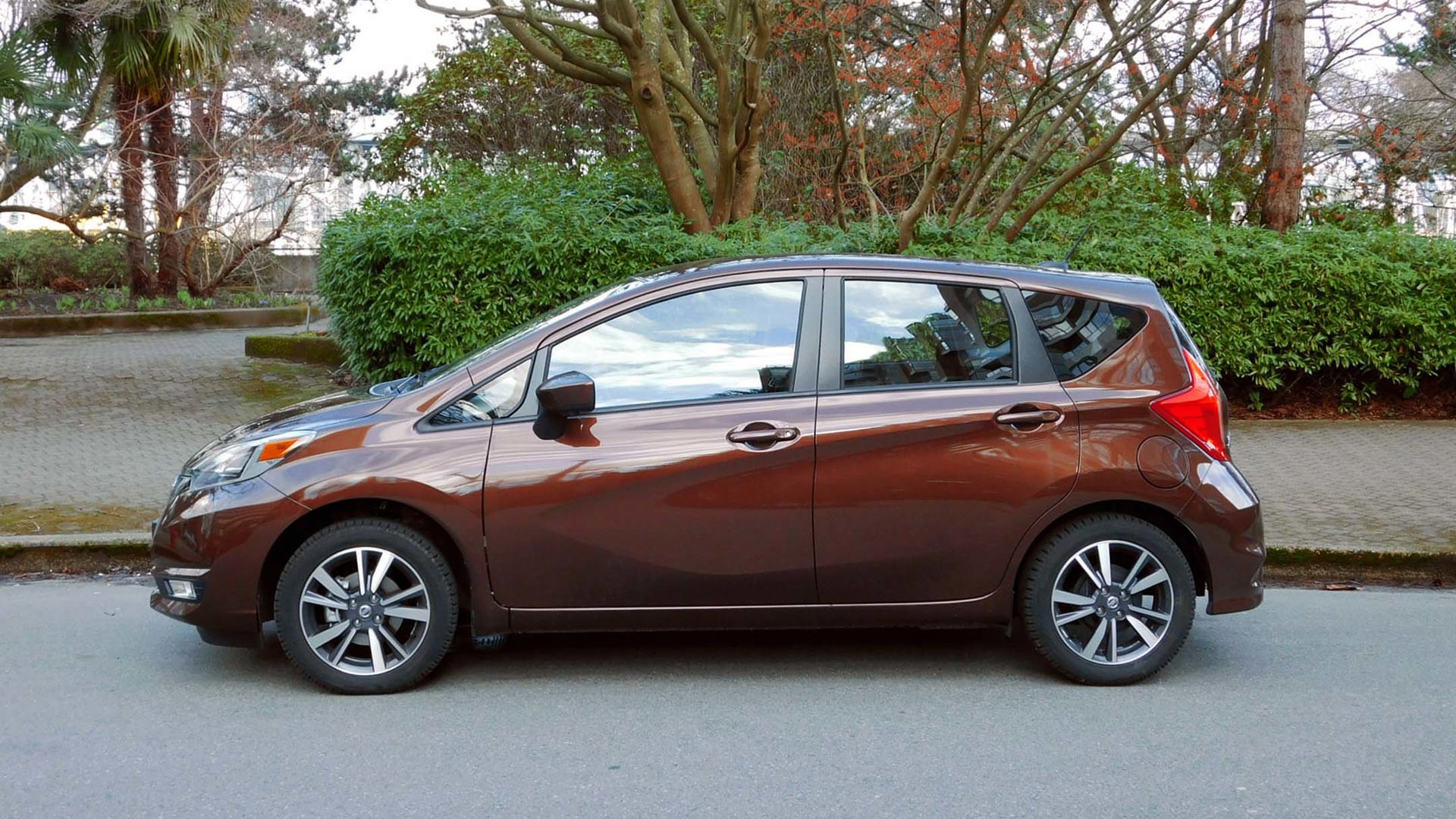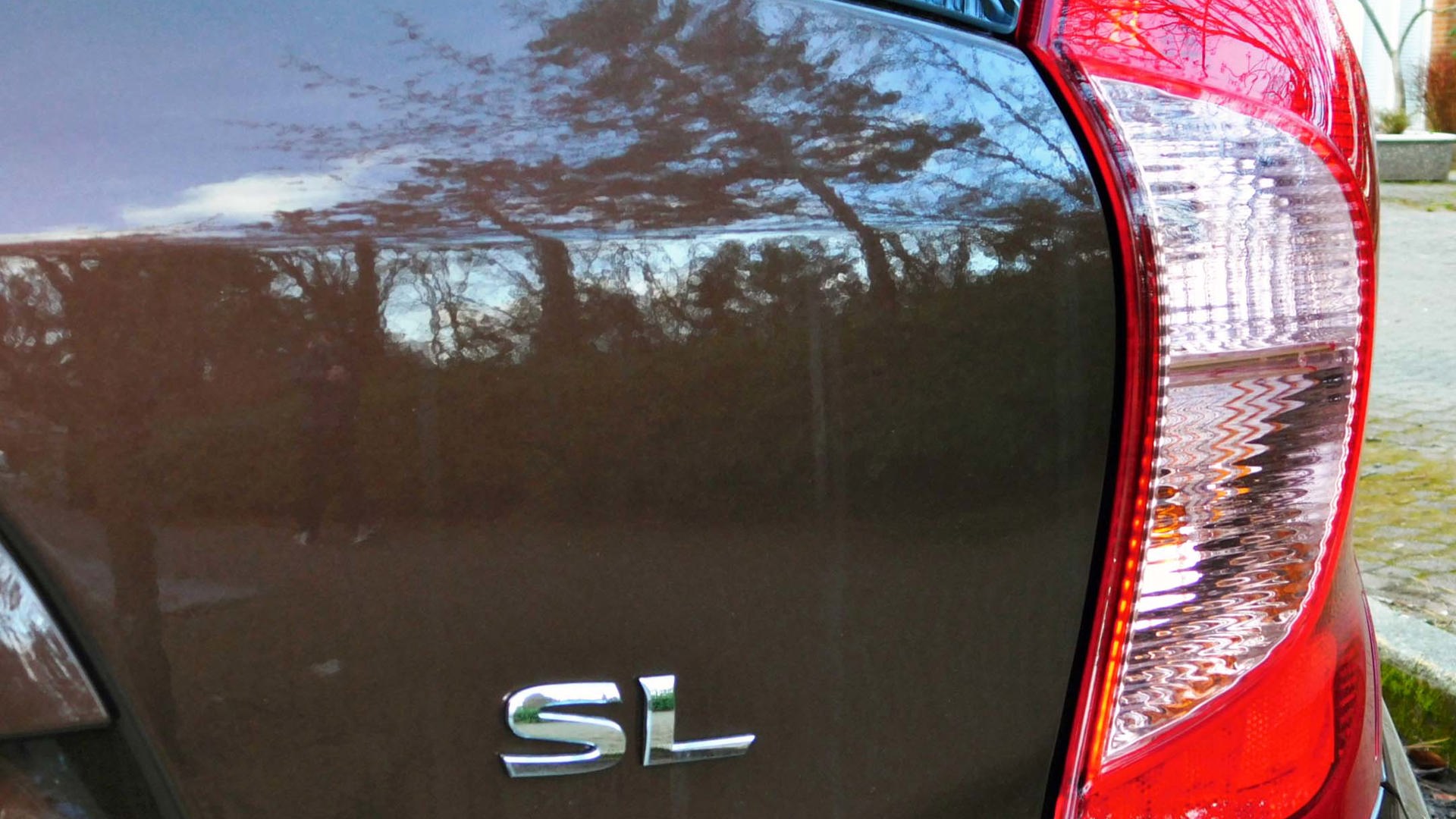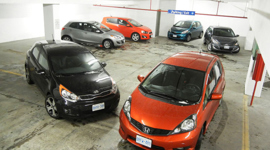 AutoTrader SCORE
AutoTrader SCORE
-
STYLING7/10
-
Safety7/10
-
PRACTICALITY7/10
-
USER-FRIENDLINESS7/10
-
FEATURES6/10
-
POWER6/10
-
COMFORT6/10
-
DRIVING FEEL7/10
-
FUEL ECONOMY8/10
-
VALUE7/10
First introduced in North America for 2014, Nissan’s Versa Note hatchback received a bit of a styling update for 2017 with a new “V-motion” style grille at the front and upgraded fascia at the rear. It’s a little bit of visual excitement for a car that tends towards the subcompact segment’s middle ground, and puts its emphasis on efficiency and interior space.
The Versa Note’s cabin is airy and spacious, and you can happily fit two full-sized adults in the back seat with plenty of legroom to spare.
In these regards, Nissan’s pleasant-looking little hatchback does very well indeed.
With a 109 hp 1.6L four-cylinder DOHC engine hooked up to a CVT automatic and driving the front wheels, the Versa Note boasts miserly official fuel consumption ratings of 7.6 / 6.2 L/100 km city/highway (or 8.6 / 6.6 L/100 km with the base S and SV trims’ standard-issue five-speed manual).
After a week of exclusively city driving, my average economy with the CVT-equipped Versa Note SL was reasonably close to the official number at 8.0 L/100 km. Taking into account the test car’s winter tires and my typically heavy-footed driving style, that’s actually pretty impressive.
Inside, the Versa Note’s cabin is airy and spacious, and you can happily fit two full-sized adults in the back seat with plenty of legroom to spare. The cargo area, at 532 L, will easily haul a week’s worth of groceries and it has a nifty and easily operated dual-height floor system that provides a hidden cargo area beneath the floor when set to the raised position. Fold the rear seats and you get a reasonably flat loading area with 1,084 L of capacity.
Value-wise, at a starting price of $14,498 for the base car and with my nicely equipped SL test car clocking in at $19,748, the Versa Note scores well. All Versa Notes come with air conditioning, Bluetooth hands-free phone system, tilt steering, split-folding rear seat, heated power mirrors, and a four-speaker AM/FM/CD audio system with auxiliary jack. The SV trim ($16,898) adds key features including power windows, power locks with remote entry, heated front seats, colour audio display, Bluetooth streaming audio, USB port, cruise control, hands-free text messaging, rear-view monitor and a leather-wrapped steering wheel.
My test car’s SL trim added higher-end features such as 16-inch alloy wheels, proximity key with pushbutton ignition, 5.8-inch display audio with satellite radio, navigation system, fog lights, around-view monitor, variable intermittent wipers and included CVT automatic.
Thus equipped, the Versa Note certainly doesn’t feel low-rent, but neither does the whole quite add up to the sum of its parts. It’s roomy enough for sure, and that equates to good basic comfort, but the seats lack contour so you end up somewhat perched on them, and the steering wheel tilts but doesn’t telescope, so taller drivers (myself included at 5'11") may find the steering wheel placement less than perfect. I was also unimpressed with the stout A-pillars, which sweep forward to create substantial blind spots. Nissan has tried to remedy matters with small pillar windows ahead of the mirrors, but I still found myself surprised on more than one occasion by pedestrians suddenly appearing where I’d intended to turn.
Interior materials include quite a bit of hard plastic, as expected for the segment, but the finishes are good and the overall design is quite nice-looking. Everything appears well put together and the ergonomics are sound, including the simple and easy-to-understand climate control knobs. The leather-wrapped steering wheel, which comes in all trims except the base S model, really pulls things up a notch. My only disappointment was that the door armrests don’t have any padding.
In terms of tech, the SL trim has pretty much everything you might hope for in a small car, and even a little more. The excellent around-view camera means that I can’t complain too much about rearward visibility. The display audio/nav system responds quickly and sounds good, although it has a bit of an aftermarket look and feel, and the small touchpoints can be tricky to use for those of us who buy size L gloves.
As far the driving experience goes, if your requirements are simply to get from point A to point B economically and in reasonable comfort, the Versa Note fills the bill just fine. It’s quiet and civilized when moseying gently along, and the ride is well-controlled and comfortably compliant, with a minimum of the kind of choppiness sometimes evident in short-wheelbase hatchbacks.
But don’t look here for driving excitement, because that’s not the Versa Note’s forte. When you mash the throttle, the car can scoot along reasonably quickly, but the drivetrain buzzes and drones loudly, practically begging you to back off and enjoy the journey at a more relaxed and frugal pace. Handling is likewise tuned for relaxed driving – the Versa Note is easygoing and feels well-sorted when driven reasonably, but it becomes somewhat squishy and unsettled if you push it in corners, with the front wheels’ limits of traction easy to find.
On the safety front, the Versa Note has a complement of six air bags (dual front, side and side curtain), vehicle dynamic control and traction control, and while the full roster of IIHS and NHTSA crash tests haven’t yet been published, together with the Versa Sedan it has good scores in the tests it has completed.
The Versa Note is undeniably a very practical choice, and in fact won our most-recent sub-compact car comparison test, but it’s hardly alone in that crowded segment, and most of its rivals offer their own particular charms. The Honda Fit (starting at $14,950) edges out the Versa Note in terms of cargo capacity and versatility. The Ford Fiesta ($16,348) has the advantage in terms of an engaging driving experience, but also the smallest interior in the segment. Toyota’s Prius c ($21,975) takes the prize for city efficiency with its 4.9 L/100 km city rating, but it may take a while to offset its higher base price. And Hyundai’s Accent ($13,999) makes a slightly stronger value statement (not counting supermini cars like Nissan’s tiny Micra, which offers the ultimate bargain hunters’ deal at a starting MSRP of $9,988).
All-in-all then, depending on your specific desires and requirements, the Nissan Versa may not necessarily represent the best available subcompact hatch choice – not if you’re looking for the sportiest drive, the biggest cargo capacity or the lowest base price – but its middle-ground appeal, spacious interior and frugal fuel economy mean that it remains a solid contender.
| Engine Displacement | 1.6L |
|---|---|
| Engine Cylinders | 4 |
| Peak Horsepower | 109 hp |
| Peak Torque | 107 lb-ft |
| Fuel Economy | 7.6/6.2/7.0 L/100km cty/hwy/cmb |
| Cargo Space | 532 L |
| Model Tested | 2017 Nissan Versa Note SL |
| Base Price | $19,748 |
| A/C Tax | $100 |
| Destination Fee | $1,600 |
| Price as Tested | $21,583 |
|
Optional Equipment
$135 – Metallic paint $135
|
|













































